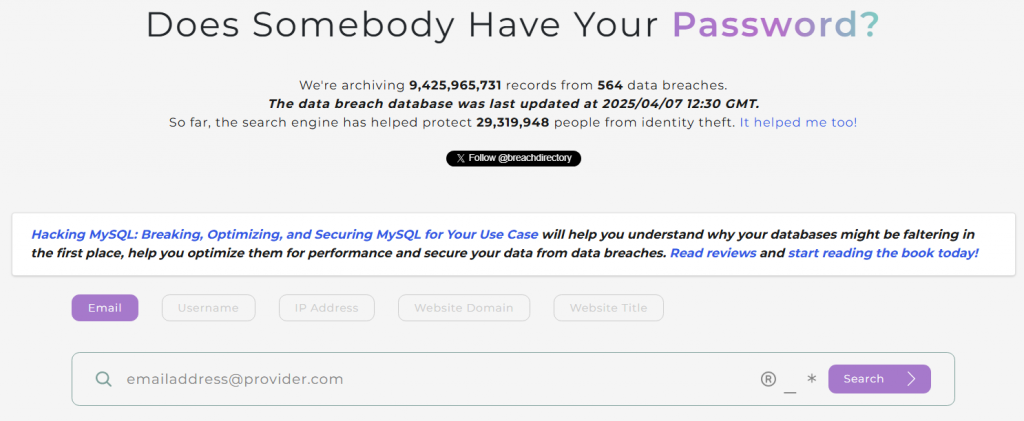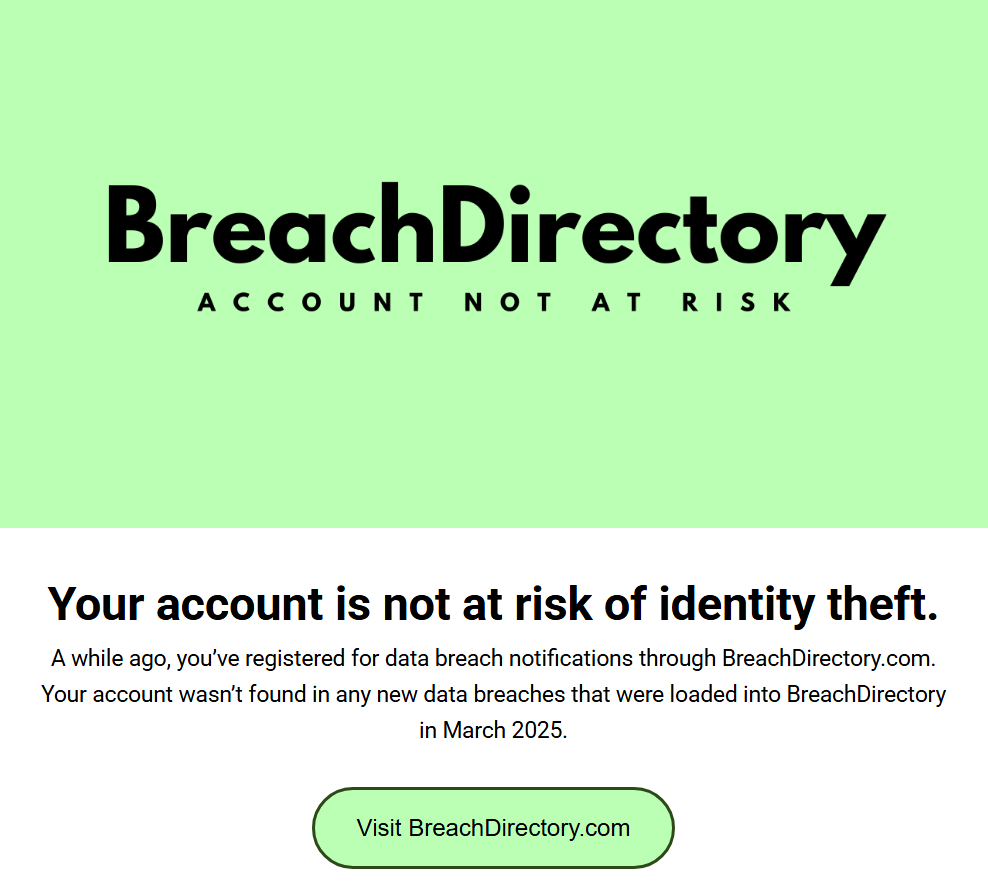This blog will walk you through multiple paths to take once you find yourself at the closing gate of cybersecurity internships.
Preface
You did it! You have completed your cybersecurity internships. Woohoo! Feels great, doesn’t it? It does.
For many, cybersecurity internships are a great step toward a career in cybersecurity – cybersecurity internships have been covered on the BreachDirectory blog before where BreachDirectory has explored what to expect from a cybersecurity internship, how much cybersecurity internships are paid, and how best to obtain one.
However, after you’ve completed cybersecurity internships, things are just beginning. Things are only just beginning because cybersecurity internships are the first step into a professional career – a career that often lasts more than 40 or even 50 years. Here’s how to get the best of what’s coming.
What to Do After Cybersecurity Internships?
After your cybersecurity internships have been completed, you may find yourself wondering what path to embark on next. BreachDirectory suggests taking a breather; taking a breather, then thinking about your career goals in three, five, or ten years.
As you take a breather, make use of the BreachDirectory data breach search engine. Then, come back to this blog and continue taking a deep dive into life after cybersecurity internships.

Made use of the BreachDirectory data breach search engine? That’s great – that’s great because data breach search engines such as the one available on BreachDirectory allow you to complete a couple of things:
- Data breach search engines facilitate quick and easy access to hundreds or even thousands of data breaches.
- Data breach search engines often come with a BreachDirectory API capability allowing you to implement the data inside of the data breach search engine into your project and use it for your use case.
- Data breach search engines facilitate the ability to search through hundreds of data breaches using different search methods like the wildcard or the regex search method. These methods allow for searching with fuzzy matching – e.g. a search for “demo” would return “demonstration”, “demon 123”, and other results, in essence expanding the search capabilities of the data breach search engine and providing more usefulness for your use case.
Such use cases of data breach search engines like BreachDirectory.com will assist your projects: projects that will help you become a better software, database, or security professional. Some use cases of BreachDirectory.com include university assignments, personal projects, or assistance for cybersecurity companies providing threat intelligence to their customers.
As you build your project, you will inevitably learn new things as you will come across obstacles, problems, and issues you need to solve, and possibly receive feedback from the users using your application. Once you receive feedback, keep on working on your application and soon enough, you will have something impressive to mention on your resume.
As you’re going about it, perhaps you’d even be interested in diving deeper into the database behind your application – if that’s the case, Hacking MySQL: Breaking, Optimizing, and Securing MySQL for Your Use Case will be a great starting point because:
- Hacking MySQL will walk you through the reasons why your databases may be faltering – Hacking MySQL is not your typical book about database performance or security optimization. Instead, the book walks readers through their own actions that make databases perform slower or become subject to hacking attacks. Once that’s done, it helps readers optimize their database architecture and infrastructure and protect it from hacker attacks to come.
- Hacking MySQL can be read in both PDF and print formats which means that no matter what you prefer in books, should you prefer to receive them in print or a PDF edition, you will have something to take away regardless.
- Hacking MySQL will help you strengthen your database infrastructure which is vital no matter what projects or applications you may find yourself building.
Once you got your foot in the door by completing cybersecurity internships and find yourself building applications, especially if they’re security-related, you will inevitably walk yourself through concepts like the OWASP Top 10. Once you walk yourself through them, you will gain more and more experience, and eventually, become a mid-level or Senior developer.
Project Ideas After Cybersecurity Internships
Here are some ideas for your cybersecurity projects:
- A Web Application Firewall – if you’re into security, building a small WAF would be a great starting point. Did you know that the founder of BreachDirectory.com started from this path by building a WAF more than a decade ago?
- A search engine – another great way to test your skills in the real world would be by building a search engine. The search engine doesn’t have to concern data breaches – it doesn’t have to be a data breach search engine – however, building a search engine to search for used cars, phone models, or perhaps aggregating and searching for job listings for other junior developers could be a great idea.
- A password strength tester – another great idea after cybersecurity internships would be to build a password strength tester. Think about it – such a cybersecurity project is likely to involve saving data in the browser (you wouldn’t store or provide user input straight to a database, would you?), you would deal with sensitive data (passwords) so you would have to think of ways to protect them (the usage of a previously built WAF, anyone?), and so on. After all, such a project would be a great way to step into the privacy world – and should you have hundreds or even thousands of satisfied users, you will certainly have something to boast about in your resume.
- Malicious IP detector – this cybersecurity project idea is similar to that of a WAF, just a twist: instead of detecting malicious input by a user, you would detect their IP addresses. I’ve even heard of cybersecurity companies making you pass code tests that involve detecting malicious traffic and should you have such a project under your belt, they may even count it as a code test! Woohoo!
- Penetration testing tools – another idea for a cybersecurity project would be to build something related to penetration testing. Penetration testing tools were, are, and will be on the rise because of the rise of cyberattacks and related threats, so why not build a pentesting tool? If there’s enough of a necessity for it, such a tool may as well become your future employer too!
Aside from those projects, there are numerous cybersecurity internships that you can find yourself completing; some of them will inevitably have to do with privacy, some of them will concern application security, and some of them will perhaps be related to social engineering. No matter which path you choose, securing yourself on the web and beyond its limits is crucial: this is what data breach notification services on BreachDirectory will help you to do: data breach search engines will help you ensure your account is not at risk of identity theft, and if it is, advise you on what to do and what actions to take so you don’t fall victim to credential stuffing and related attacks, and data breach notifications will notify you if your account ever falls victim to identity theft without you having to lift a finger. Cool, right?

Summary
Cybersecurity internships are a great way to get your foot in the door and once the door has been opened and you’ve entered the area of cybersecurity, your path shouldn’t stop there; cybersecurity projects are a great way to complement your skills as a professional and start building your reputation as a respected developer or security engineer.
As you’re on this path, don’t forget to frequently visit conferences, read books, and make frequent use of data breach search engines and their data breach notifications to ensure your data is not compromised.
FAQ
What Projects Should I Complete After Cybersecurity Internships?
As you’re nearing the end of your cybersecurity internships, look into simple, but useful projects like firewalls, search engines, password strength testers, detectors of malicious IP addresses, or even small penetration testing tools. As always, remember that the BreachDirectory API is a great companion for everyone building, using, or otherwise acting on applications that deal with data breaches too!
Why Should I Register for BreachDirectory Data Breach Notifications?
Consider registering for BreachDirectory data breach notifications because notifications will keep you sleeping soundly at night and allow you to know when your account has been compromised. If it hasn‘t been compromised, you will receive monthly alerts too.
What‘s a Good Way to Stand Out After Completing Cybersecurity Internships?
To stand out after completing cybersecurity internships, build projects using the BreachDirectory API or other tools, read books like Hacking MySQL: Breaking, Optimizing, and Securing MySQL for Your Use Case, and consider attending industry events like Database Frontiers – an upcoming conference about database availability, security, and performance.
